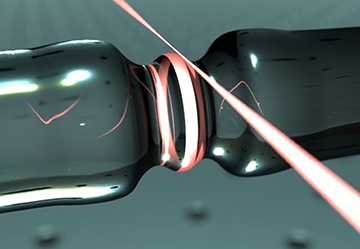
A UK-led collaboration has shown it can plot the phase-space distribution of an acoustic state by firing a laser beam at a microresonator (shown here coupled to an optical fiber) and then applying optical heterodyne tomography combined with single-photon detection. [Image: Jack Clarke]
The quanta of sound known as phonons could potentially exist in large-scale, long-lived quantum states. Such states would come in very handy for sensing, computing and communication. But to date, scientists have been unable to generate and detect such states as readily as they can quantum states of light.
Now, an international collaboration of researchers has taken a step towards such state control, by using an optical setup that can not only add and subtract individual phonons from a mechanical oscillator but can also characterize the resulting state of sound (Phys. Rev. Lett, doi: 10.1103/PhysRevLett.127.243601).
Photon–phonon interplay
Quantum states can now be created and controlled in a wide variety of physical systems, from single photons and ions to large molecules and superconducting circuits. Extending these capabilities to mechanical oscillators would enable larger-scale quantum states that could be exploited in memory devices. It could also help scientists better understand the boundary between the quantum and classical worlds.
Michael Vanner at Imperial College London, UK, and colleagues in the UK, Australia, Denmark and Germany, in common with other research groups around the world, are exploring the interplay between photons and phonons using optical microresonators. The team uses devices that are able to confine both light and sound waves, with the light circulating up to a million times around the edge of the devices and interacting with high-frequency vibrations of the microresonator material.
The researchers’ experiments, carried out at room temperature, involve adding or taking away one phonon’s worth of energy by directing a laser beam at the mircoresonator and then detecting a single scattered photon shifted up or down in frequency. But missing so far in these experiments is a characterization of the sound field’s state after the phonon addition or subtraction. Vanner and co-workers have now achieved this by combining single-photon measurement with heterodyne detection.
From acoustic state to light field
The latest experiment involved a 40-µm-radius microresonator made from low optical and acoustic loss barium fluoride, coupled to a tapered optical fiber. The researchers used the microresonator to subtract both single phonons and pairs of phonons from the sound field, heralding the formation of the acoustic state by detecting the photons given off using avalanche detectors. Having thus transduced the acoustic state onto the light field, they then used optical heterodyne tomography techniques to carefully characterize the transduced acoustic state.
The researchers used photons in an optical microresonator to subtract both single phonons and pairs of phonons from the sound field—and thereby transduce the acoustic state onto the light field.
To determine the acoustic phase-space distributions, the researchers carried out 240,000 measurements for each of the three states under investigation: the initial thermal state, the state with a single phonon removed and the state with two phonons removed. They found, as expected, that the initial state yielded a classical Gaussian, or bell-shaped, distribution, while the other two generated non-Gaussian distributions—both having twin peaks in the quadrature probability distribution, with the peaks being more pronounced in the case of two-phonon subtraction. (A similar feat has been achieved by Amir Safavi-Naeini and colleagues at Stanford University in the USA, who have also observed non-Gaussian phase-space distributions in a mechanical oscillator.)
Toward quantum memory?
Vanner says that these signatures are close to those of quantum states but lack a key ingredient: a feature known as “Wigner negativity.” To observe that, he says, will require changes to improve the experimental efficiency, including operating at cryogenic temperatures and using even smaller microresonators. But if they can succeed, Vanner adds, they might then be able to make a quantum memory device that could “efficiently write and read quantum states to and from the acoustic mode” as well as being able to probe the quantum-to-classical transition.

